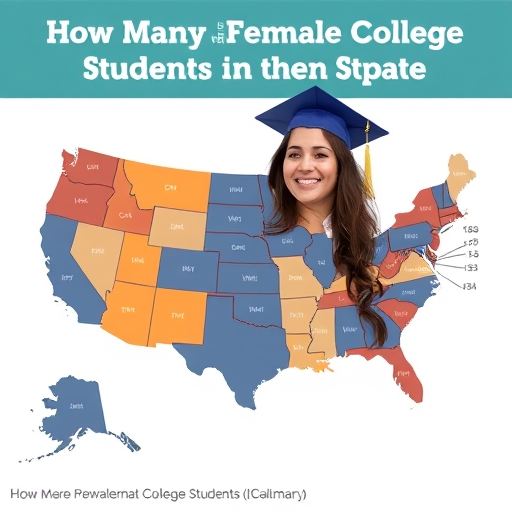How Many Female College Students in the U.S.?
The educational landscape in the United States is continually evolving, with significant changes in demographics and enrollment patterns over the past few decades. One notable trend is the increase in female college students. This article will explore the current statistics regarding female college enrollment, historical trends, factors influencing these changes, and the implications for the future.
Current Statistics on Female College Enrollment
As of the 2021-2022 academic year, women represented a significant portion of college students in the United States. According to the National Center for Education Statistics (NCES), here are some key statistics:
- Total Enrollment: Approximately 19.6 million students were enrolled in degree-granting postsecondary institutions in the U.S.
- Female Students: About 11.5 million of these students were women, accounting for approximately 58.7% of total enrollment.
- Male Students: In contrast, male students represented around 41.3%, with approximately 8.1 million enrolled.
- Changing Perceptions: The perception of women’s roles in society has evolved, with greater emphasis placed on higher education and career advancement.
- Empowerment Movements: The feminist movement and advocacy for women’s rights have played a crucial role in encouraging women to pursue higher education.
- Job Market Demand: Many industries now require advanced degrees, leading women to seek higher education to remain competitive.
- Income Potential: Women are increasingly recognizing the financial benefits of obtaining degrees, as statistics show that college graduates generally earn more than those without degrees.
- Title IX: Enacted in 1972, Title IX has played a significant role in promoting gender equity in education, providing women with greater access to educational opportunities.
- Scholarships and Programs: Many colleges and universities offer scholarships targeted at female students, particularly in fields where women have been historically underrepresented.
- Mentorship Programs: Initiatives aimed at supporting women in higher education have become more common, providing guidance and resources to female students.
- Networking Opportunities: Women-focused organizations and networks within colleges help foster connections and support among female students.
- STEM Fields: Women are still underrepresented in science, technology, engineering, and mathematics (STEM) programs. Although the number of women pursuing these degrees is increasing, challenges remain in retention and completion rates.
- Leadership Roles: Women often face barriers to leadership positions within college organizations and programs, which can impact their educational experience.
- Family Responsibilities: Many female students juggle college with family obligations, which can affect their academic performance and mental health.
- Part-Time Work: Balancing part-time jobs with coursework can be particularly challenging for female students, especially those who are single parents.
- Stress and Anxiety: The pressures of college life can lead to increased stress and anxiety, particularly among female students who may feel the need to excel in multiple areas.
- Support Services: Access to mental health resources is crucial, but some institutions may lack adequate support systems.
- Increased Participation in STEM: Efforts to encourage more women to pursue STEM degrees may lead to greater representation in these fields.
- Graduate Programs: The enrollment of women in graduate programs is also on the rise, which may lead to more women in leadership roles and high-paying careers.
- Workforce Diversity: Increasing female enrollment in colleges can lead to a more diverse workforce, which is beneficial for innovation and economic growth.
- Social Change: As more women obtain higher education, societal norms regarding gender roles may continue to evolve, promoting greater equality.
Enrollment Trends Over Time
The proportion of female college students has consistently increased over the decades. Here’s a brief overview of enrollment trends:
| Year | Total Enrollment | Female Enrollment | Percentage of Female Students |
|---|---|---|---|
| 1980 | 12.6 million | 6.2 million | 49.2% |
| 1990 | 14.5 million | 7.6 million | 52.4% |
| 2000 | 15.3 million | 8.1 million | 52.9% |
| 2010 | 21.0 million | 11.3 million | 53.8% |
| 2021-2022 | 19.6 million | 11.5 million | 58.7% |
As illustrated in the table above, female enrollment has increased significantly since 1980, both in absolute numbers and as a percentage of total enrollment. This shift reflects broader societal changes regarding gender roles and education.
Factors Influencing Female Enrollment
Several factors have contributed to the increase in female college students in the U.S.:
1. Cultural Shifts
2. Economic Factors
3. Educational Policies
4. Support Systems
Challenges Faced by Female College Students
Despite the progress made, female college students still face various challenges in their educational journeys:
1. Gender Disparities in Certain Fields
2. Work-Life Balance
3. Mental Health Concerns
The Future of Female College Enrollment
The trends in female college enrollment suggest a promising future for women in higher education. As societal attitudes continue to shift and educational policies evolve, it is likely that the representation of women in higher education will continue to grow.
Potential Areas for Growth
Implications for Society
Frequently Asked Questions (FAQs)
1. What percentage of college students in the U.S. are female?
As of the 2021-2022 academic year, approximately 58.7% of college students in the U.S. were female.
2. How has female college enrollment changed over the years?
Female college enrollment has increased significantly since the 1980s, rising from 49.2% in 1980 to 58.7% in 2021-2022.
3. What challenges do female college students face?
Female college students may face challenges such as gender disparities in STEM fields, work-life balance issues, and mental health concerns.
4. What factors contribute to the increase in female college enrollment?
Factors include cultural shifts, economic factors, educational policies, and support systems aimed at promoting women’s education.
5. Are there initiatives to support women in STEM?
Yes, many colleges offer mentorship programs, scholarships, and networking opportunities specifically designed to support women pursuing STEM degrees.
Conclusion
The increase in female college students in the U.S. is a reflection of changing societal values, economic demands, and educational policies. While challenges remain, the overall trend points towards a more equitable educational landscape where women are not only participating but thriving in higher education. As we look to the future, it is essential to continue supporting female students to ensure that they have the resources and opportunities needed to succeed.





